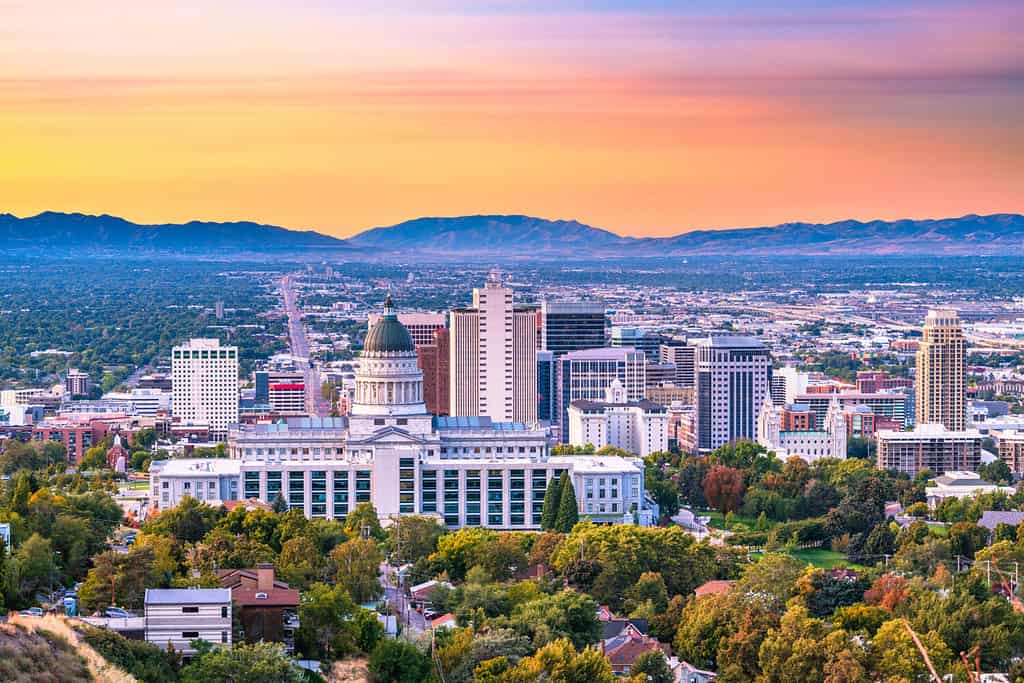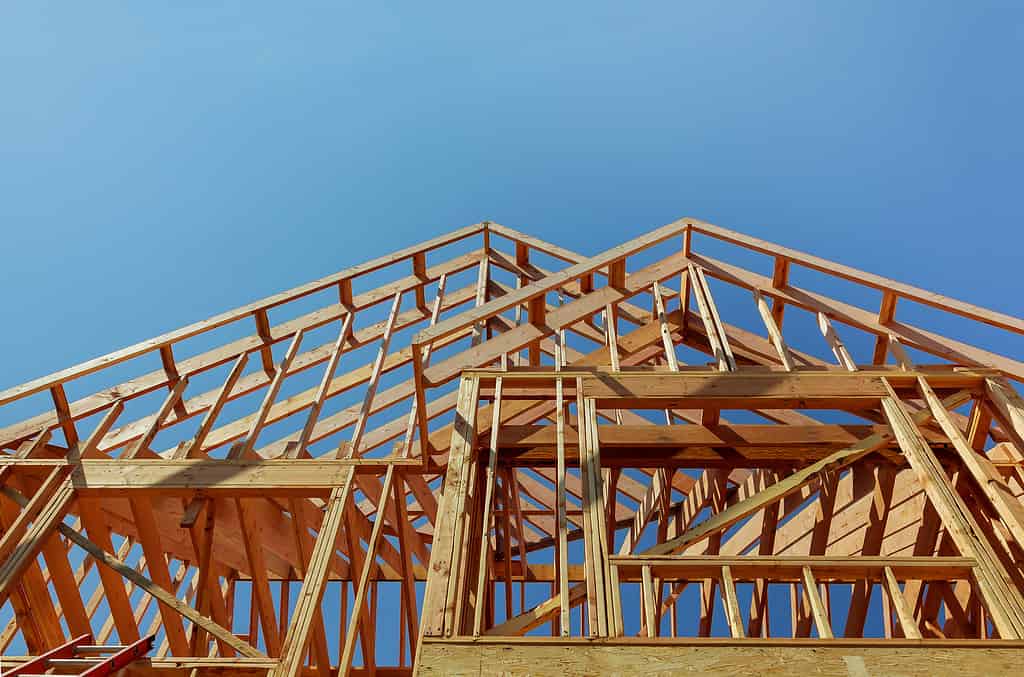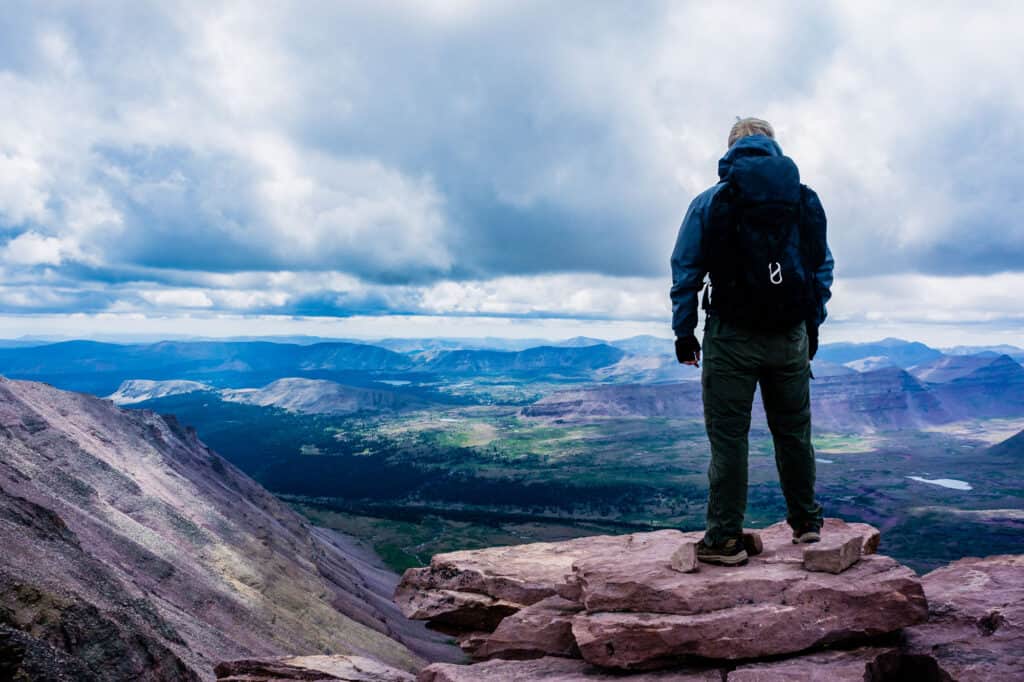Utah is a happening place! The state’s population is growing like crazy. In 1970, only 1.06 million people lived there, but by 2020, that number had increased to 3.3 million people. That’s more than a 200-percent increase! Just this year, U.S. News and World Report analyzed all the states by 71 different metrics and named Utah the best state to live in. What’s so great about Utah? We’ll sum it up for you in three reasons.
Three Reasons People are Moving to Utah

Salt Lake City is the largest city and capital of Utah.
©Sean Pavone/Shutterstock.com
Utah has had a steady migration of people from other states. California and Texas are two heavily populated states that have a steady outflow of population to Utah. These are some of the factors that make Utah an attractive destination:
1. Job Opportunities

Utah has a lot of job opportunities in diverse economic sectors.
©SALMONNEGRO-STOCK/Shutterstock.com
Since the COVID-19 pandemic, a large number of people have continued to work remotely, freeing them up to move to other parts of the country for factors other than the presence of local jobs. However, Utah has advantages that attract all types of workers. The state economy is diversified between agriculture, mining, manufacturing, commerce, tourism, and technology. This diversity makes the state virtually recession-proof. The unemployment rate is currently just 2.6%, compared to 3.8% in the country as a whole. For the past 16 years, Utah has ranked #1 in the country for economic outlook by Rich States, Poor States: ALEC-Laffer State Economic Competitiveness Index. Moreover, US News and World Report ranked it first in the nation in 2023 for its strong economy and fiscal stability.
2. Affordable Cost of Living

Utah is generally an affordable place to live. The cost of living is close to the national average.
©photovs/ via Getty Images
The cost of living is slightly higher in Utah than the national average, but not excessively so. Utah ranks 21st in the country with a cost-of-living index of 102.8 (in reference to the national average, set at 100). The average living wage in Utah is $16.98, the minimum wage is $7.25, and the median household income is $87,649. The growing population and strong economy contribute to the cost of living. The lowest cost of living in the country is in Mississippi, where job opportunities are more limited.
3. High Quality of Life

Utah offers spectacular natural beauty and recreation opportunities like hiking, skiing, and rafting.
©Greg Rorem/Shutterstock.com
Utah ranks among the top states in the country in health care, education, infrastructure, the natural environment, and low crime rates. Utah has gorgeous unspoiled natural beauty, especially in its five national parks: Zion, Arches, Bryce Canyon, Capitol Reef, and Canyonlands. Its arid desert and mountain climate make it a bright, sunny place to live. It is a popular destination for people who enjoy skiing, snowboarding, and other winter sports. Film lovers can attend the prestigious annual Sundance Film Festival in Salt Lake City, Park City, and the Sundance Resort near Provo.
Culturally and politically, Utah has a reputation for being dominated by the Latter-Day Saints and embracing conservative, traditional values. This makes it an attractive destination for like-minded people around the country, especially those seeking a family-oriented culture. However, only 68% of the people in the state are Mormons, and in Salt Lake City itself, that percentage drops to less than 50% In fact, Salt Lake City is considered one of the most LGBT+ friendly cities in the country and a prime location for creatives in many fields.
What Role Does Fertility Play in Utah’s Population Growth?

Utah’s religious influences since pioneer days have encouraged and supported large families.
©Marian Weyo/Shutterstock.com
Many of the early settlers of Utah were members of the Church of Jesus Christ of Latter-Day Saints, popularly known as Mormons. The teachings of the church originally supported polygamy and have continued to encourage and support large families. This created a higher-than-average fertility rate in Utah. In recent years the fertility rate has slowed, but Utah continues to have the fourth-highest fertility rate in the country, after the Dakotas and Nebraska. Even as fertility rates begin to decrease, there is a certain “population momentum” from high birth rate years that creates a “bulge” of high population moving forward.
What Counties of Utah are Growing Fastest?
The chart below shows which counties of Utah are growing fastest. These are annual growth percentages from 2021-22. Because many of Utah’s counties have low populations, even small numbers of people moving into the county can give it a high growth rate on a percentage basis.
| Rank | County | Population Growth |
|---|---|---|
| 1 | Tooele County | 4.17% |
| 2 | Daggett County | 3.79% |
| 3 | Washington County | 3.24% |
| 4 | Iron County | 3.15% |
| 5 | Juab County | 3.08% |
What Counties of Utah Have the Largest Populations?
About 75% of Utah’s population is concentrated in four counties along the Wasatch Front, a semi-arid region on the eastern side of the Great Basin: Salt Lake, Utah, Davis, and Weber. Below is a ranked list of all 29 counties in the state from largest to smallest population.

St. George is the county seat of Washington County, one of the fastest growing localities in Utah.
©Rosie Osuna/iStock via Getty Images
| Rank | County | Population |
|---|---|---|
| 1 | Salt Lake | 1,186,257 |
| 2 | Utah | 702,434 |
| 3 | Davis | 369,948 |
| 4 | Weber | 269,561 |
| 5 | Washington | 197,680 |
| 6 | Cache | 140,173 |
| 7 | Tooele | 79,934 |
| 8 | Iron | 62,429 |
| 9 | Box Elder | 61,498 |
| 10 | Summit | 43,036 |
| 11 | Uintah | 37,141 |
| 12 | Wasatch | 36,619 |
| 13 | Sanpete | 29,724 |
| 14 | Sevier | 22,069 |
| 15 | Carbon | 20,571 |
| 16 | Duchesne | 20,161 |
| 17 | San Juan | 14,359 |
| 18 | Millard | 13,330 |
| 19 | Morgan | 12,832 |
| 20 | Juab | 12,567 |
| 21 | Emery | 10,099 |
| 22 | Grand | 9,769 |
| 23 | Kane | 8,227 |
| 24 | Beaver | 7,327 |
| 25 | Garfield | 5,281 |
| 26 | Wayne | 2,645 |
| 27 | Rich | 2,628 |
| 28 | Piute | 1,487 |
| 29 | Daggett | 1,014 |
When Has Utah’s Population Grown the Most?

The ultra-modern Salt Lake City International Airport serves 26 million travelers a year.
As you can see in the following chart, Utah’s population experienced some of its highest growth rates in the 1970s, with some years approaching just below 4% growth. The year 2000 was the highest growth year, 5.38%. In the 2010s and 20s, population growth is still high but has noticeably slowed. For comparison, Florida, at a 1.9% growth rate, and Idaho at 1.8% are the highest-growing states in the country today. In recent years the overall American population growth rate has been between .3 and .5 %.
| Year | Population | Growth Rate |
|---|---|---|
| 2022 | 3,380,800 | 1.25% |
| 2021 | 3,339,113 | 1.68% |
| 2020 | 3,283,785 | 2.51% |
| 2019 | 3,203,383 | 1.53% |
| 2018 | 3,155,153 | 1.66% |
| 2017 | 3,103,540 | 1.95% |
| 2016 | 3,044,241 | 2.03% |
| 2015 | 2,983,626 | 1.54% |
| 2014 | 2,938,327 | 1.36% |
| 2013 | 2,898,773 | 1.56% |
| 2012 | 2,854,146 | 1.40% |
| 2011 | 2,814,797 | 1.42% |
| 2010 | 2,775,413 | 1.91% |
| 2009 | 2,723,421 | 2.27% |
| 2008 | 2,663,029 | 2.51% |
| 2007 | 2,597,746 | 2.86% |
| 2006 | 2,525,507 | 2.76% |
| 2005 | 2,457,719 | 2.34% |
| 2004 | 2,401,580 | 1.76% |
| 2003 | 2,360,137 | 1.52% |
| 2002 | 2,324,815 | 1.80% |
| 2001 | 2,283,715 | 1.75% |
| 2000 | 2,244,502 | 5.38% |
| 1999 | 2,129,836 | 1.39% |
| 1998 | 2,100,562 | 1.70% |
| 1997 | 2,065,397 | 2.13% |
| 1996 | 2,022,253 | 2.30% |
| 1995 | 1,976,774 | 2.40% |
| 1994 | 1,930,436 | 2.90% |
| 1993 | 1,875,993 | 2.99% |
| 1992 | 1,821,498 | 2.80% |
| 1991 | 1,771,941 | 2.44% |
| 1990 | 1,729,722 | 1.40% |
| 1989 | 1,705,864 | 0.98% |
| 1988 | 1,689,372 | 0.67% |
| 1987 | 1,678,119 | 0.92% |
| 1986 | 1,662,834 | 1.21% |
| 1985 | 1,642,910 | 1.27% |
| 1984 | 1,622,342 | 1.72% |
| 1983 | 1,594,943 | 2.35% |
| 1982 | 1,558,314 | 2.83% |
| 1981 | 1,515,471 | 2.91% |
| 1980 | 1,472,595 | 3.69% |
| 1979 | 1,420,238 | 3.86% |
| 1978 | 1,367,510 | 3.64% |
| 1977 | 1,319,512 | 3.50% |
| 1976 | 1,274,928 | 3.15% |
| 1975 | 1,236,030 | 2.96% |
| 1974 | 1,200,471 | 2.60% |
| 1973 | 1,170,040 | 3.05% |
| 1972 | 1,135,449 | 3.11% |
| 1971 | 1,101,192 | 3.96% |
| 1970 | 1,059,273 | 1.17% |
What Does the Future Hold for Utah?
Utah’s population is expected to grow rapidly until it doubles again to 6.84 million by 2060. This will surely increase the state’s political and cultural influence and lead to even more growth. The state will need to be attentive to how to manage growth sustainably so as not to overstress limited supplies of water and other resources and to preserve the state’s priceless natural wonders.
The photo featured at the top of this post is © iStock.com/Kruck20
Thank you for reading! Have some feedback for us? Contact the AZ Animals editorial team.







